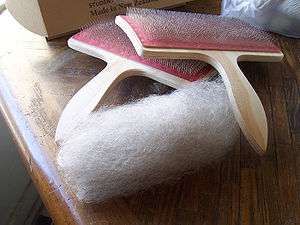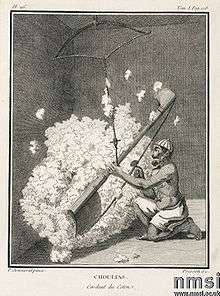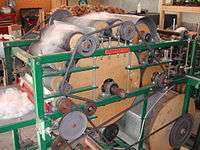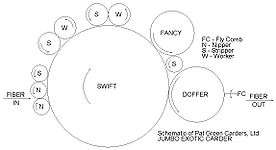Carding

Carding is a mechanical process that disentangles, cleans and intermixes fibres to produce a continuous web or sliver suitable for subsequent processing.[1] This is achieved by passing the fibers between differentially moving surfaces covered with card clothing. It breaks up locks and unorganized clumps of fibre and then aligns the individual fibers to be parallel with each other. In preparing wool fibre for spinning, carding is the step that comes after teasing.[2]
The word is derived from the Latin carduus meaning thistle or teasel,[3] as dried vegetable teasels were first used to comb the raw wool. These ordered fibres can then be passed on to other processes that are specific to the desired end use of the fibre: Cotton, batting, felt, woollen or worsted yarn, etc. Carding can also be used to create blends of different fibres or different colours. When blending, the carding process combines the different fibres into a homogeneous mix. Commercial cards also have rollers and systems designed to remove some vegetable matter contaminants from the wool.
Common to all carders is card clothing. Card clothing is made from a sturdy flexible backing in which closely spaced wire pins are embedded. The shape, length, diameter, and spacing of these wire pins is dictated by the card designer and the particular requirements of the application where the card cloth will be used. A later version of the card clothing product developed during the latter half of the 19th century and found only on commercial carding machines, whereby a single piece of serrated wire was wrapped around a roller, became known as metallic card clothing.
Carding machines are known as cards. Fibre may be carded by hand for hand spinning.
History

Science historian Joseph Needham ascribes the invention of bow-instruments used in textile technology to India.[4] The earliest evidence for using bow-instruments for carding comes from India (2nd century CE).[4] These carding devices, called kaman (bow) and dhunaki, would loosen the texture of the fibre by the means of a vibrating string.[4]
In 1748 Lewis Paul of Birmingham, England invented the hand driven carding machine. A coat of wire slips was placed around a card which was then wrapped around a cylinder. Daniel Bourn obtained a similar patent in the same year, and probably used it in his spinning mill at Leominster, but this burnt down in 1754.[5] The invention was later developed and improved by Richard Arkwright and Samuel Crompton. Arkwright's second patent (of 1775) for his carding machine was subsequently declared invalid, because it lacked originality.[6]
From the 1780s, the carding machines were set up in mills in the north of England and mid Wales. The first in Wales was in a factory at Dolobran near Meifod in 1789. These carding mills produced yarn particularly for the Welsh flannel industry.[7]
By 1838, the Spen Valley, centred on Cleckheaton had at least 11 card clothing factories and by 1893 it was generally accepted as the card cloth capital of the world, though by 2008 only two manufacturers of metallic and flexible card clothing remained in England, Garnett Wire Ltd. dating back to 1851 and Joseph Sellers & Son Ltd established in 1840.
Baird from Scotland took carding to Leicester, Massachusetts in the 1780s. In the 1890s the town produced one-third of all hand and machine cards in North America.
The process
| Bale Breaker | Blowing Room | |||||
| Willowing | ||||||
| Breaker Scutcher | Batting | |||||
| Finishing Scutcher | Lapping | |||||
| Carding | Carding Room | |||||
| Sliver Lap | ||||||
| Combing | ||||||
| Drawing | ||||||
| Slubbing | ||||||
| Intermediate | ||||||
| Roving | Fine Roving | |||||
| Mule Spinning | - | Ring Spinning | Spinning | |||
| Reeling | Doubling | |||||
| Winding | Bundling | Bleaching | ||||
| Weaving shed | Winding | |||||
| Beaming | Cabling | |||||
| Warping | Gassing | |||||
| Sizing/Slashing/Dressing | Spooling | |||||
| Weaving | ||||||
| Cloth | Yarn (Cheese)- - Bundle | Sewing Thread |

Carding: the fibres are separated and then assembled into a loose strand (sliver or tow) at the conclusion of this stage.
- The cotton comes off of the picking machine in laps, and is then taken to carding machines. The carders line up the fibres nicely to make them easier to spin. The carding machine consists mainly of one big roller with smaller ones surrounding it. All of the rollers are covered in small teeth, and as the cotton progresses further on the teeth get finer (i.e. closer together). The cotton leaves the carding machine in the form of a sliver; a large rope of fibres.[8]
In a wider sense carding can refer to the four processes of willowing, lapping, carding and drawing. In willowing the fibers are loosened . In lapping the dust is removed to create a flat sheet or lap of fibres; Carding itself is the combing of the tangled lap into a thick rope or sliver of 1/2 inch in diameter, it can then be optionally combed, is used to remove the shorter fibres, creating a stronger yarn.

In drawing a drawing frame combines 4 slivers into one. Repeated drawing increases the quality of the sliver allowing for finer counts to be spun.[9] Each sliver will have thin and thick spots, and by combining several slivers together a more consistent size can be reached. Since combining several slivers produces a very thick rope of cotton fibres, directly after being combined the slivers are separated into rovings. These rovings (or slubbings) are then what are used in the spinning process.[10]
For machine processing, a roving is about the width of a pencil. The rovings are collected in a drum and proceed to the slubbing frame which adds twist, and winds onto bobbins. Intermediate Frames are used to repeat the slubbing process to produce a finer yarn, and then the roving frames reduces it to a finer thread, gives more twist, makes more regular and even in thickness, and winds onto a smaller tube.[11]
Hand carders

Hand cards are typically square or rectangular paddles manufactured in a variety of sizes from 2 by 2 inches (5.1 cm × 5.1 cm) to 4 by 8 inches (10 cm × 20 cm). The working face of each paddle can be flat or cylindrically curved and wears the card cloth. Small cards, called flick cards, are used to flick the ends of a lock of fibre, or to tease out some strands for spinning off.[12]
A pair of cards is used to brush the wool between them until the fibres are more or less aligned in the same direction. The aligned fibre is then peeled from the card as a rolag. Carding is an activity normally done outside or over a drop cloth, depending on the wool's cleanliness. Rolag is peeled from the card.
Drum carders

The simplest machine carder is the drum carder. Most drum carders are hand-cranked but some are powered by electric motor. These machines generally have two rollers, or drums, covered with card clothing. The licker-in, or smaller roller meters fibre from the infeed tray onto the larger storage drum. The two rollers are connected to each other by a belt- or chain-drive so that their relative speeds cause the storage drum to gently pull fibres from the licker-in. This pulling straightens the fibres and lays them between the wire pins of the storage drum's card cloth. Fibre is added until the storage drum's card cloth is full. A gap in the card cloth facilitates removal of the batt when the card cloth is full.
Some drum carders have a soft-bristled brush attachment that presses the fibre into the storage drum. This attachment serves to condense the fibres already in the card cloth and adds a small amount of additional straightening to the condensed fibre.
Cottage carders
Cottage carding machines differ significantly from the simple drum card. These carders do not store fibre in the card cloth as the drum carder does but, rather, fibre passes through the workings of the carder for storage or for additional processing by other machines.
A typical cottage carder has a single large drum (the swift) accompanied by a pair of in-feed rollers (nippers), one or more pairs of worker and stripper rollers, a fancy, and a doffer. In-feed to the carder is usually accomplished by hand or by conveyor belt and often the output of the cottage carder is stored as a batt or further processed into roving and wound into bumps with an accessory bump winder. The cottage carder in the image below supports both outputs.
Raw fibre, placed on the in-feed table or conveyor is moved to the nippers which restrain and meter the fiber onto the swift. As they are transferred to the swift, many of the fibres are straightened and laid into the swift's card cloth. These fibres will be carried past the worker / stripper rollers to the fancy.
As the swift carries the fibres forward, from the nippers, those fibres that are not yet straightened are picked up by a worker and carried over the top to its paired stripper. Relative to the surface speed of the swift, the worker turns quite slowly. This has the effect of reversing the fibre. The stripper, which turns at a higher speed than the worker, pulls fibres from the worker and passes them to the swift. The stripper's relative surface speed is slower than the swift's so the swift pulls the fibres from the stripper for additional straightening.
Straightened fibres are carried by the swift to the fancy. The fancy's card cloth is designed to engage with the swift's card cloth so that the fibres are lifted to the tips of the swift's card cloth and carried by the swift to the doffer. The fancy and the swift are the only rollers in the carding process that actually touch.
The slowly turning doffer removes the fibres from the swift and carries them to the fly comb where they are stripped from the doffer. A fine web of more or less parallel fibre, a few fibres thick and as wide as the carder's rollers, exits the carder at the fly comb by gravity or other mechanical means for storage or further processing.
| Cottage Carder | ||||
|---|---|---|---|---|
|
| Historical Carding Machines | ||||||
|---|---|---|---|---|---|---|
|
General information
This product (rovings, rolags, and batts) can be used for spinning.
Carding of wool can either be done "in the grease" or not, depending on the type of machine and on the spinner's preference. "In the grease" means that the lanolin that naturally comes with the wool has not been washed out, leaving the wool with a slightly greasy feel. The large drum carders do not tend to get along well with lanolin, so most commercial worsted and woollen mills wash the wool before carding. Hand carders (and small drum carders too, though the directions may not recommend it) can be used to card lanolin rich wool.
See also
- Cotton mill
- Cotton-spinning machinery
- Doubling (textiles)
- Dref Friction Spinning
- Open end spinning
- Spinning
- Spinning wheel
- Textile manufacture during the Industrial Revolution
- Textile manufacturing
- Timeline of clothing and textiles technology
References
- ↑ Yilmaz, Nasire Deniz; Powell (2005). "The Technology of Terry Towel production" (PDF). Journal of Textile and Apparel, Technology and Management. North Carolina Stare University. 4 (4).
- ↑ "Preparing Wool for Handspinning". La Hottée. 27 July 2007. Retrieved 2014-09-16.
- ↑
 Chisholm, Hugh, ed. (1911). "Carding". Encyclopædia Britannica (11th ed.). Cambridge University Press.
Chisholm, Hugh, ed. (1911). "Carding". Encyclopædia Britannica (11th ed.). Cambridge University Press. - 1 2 3 Baber, Zaheer (1996). The Science of Empire: Scientific Knowledge, Civilization, and Colonial Rule in India. State University of New York Press. p. 57. ISBN 0-7914-2919-9.
- ↑ Wadsworth, A. P.; Mann, J. de L. (1931). The Cotton Industry and Industrial Lancashire. Manchester University Press. pp. 419–448.
- ↑ Fitton, R. S.; Wadsworth, A. P. (1958). The Strutts and the Arkwrights 1758-1830: a Study in the Early Factory System. Manchester University Press. pp. 65–80.
- ↑ Jenkins, J. Geraint (1969). The Welsh Woollen Industry. Cardiff. pp. 33–4.
- ↑ Collier 1970, pp. 66,67
- ↑ Collier 1970, p. 69
- ↑ Collier 1970, pp. 70
- ↑ Hills 1993, p. 4
- ↑ Matherne, Patrick. "What is Carding". Retrieved 8 May 2012.
- Nasmith, Joseph (1896). The Students Cotton Spinning (Third ed.). Deansgate, Manchester: John Heywood Ltd. p. 637.
- Collier, Ann M (1970), A Handbook of Textiles, Pergamon Press, p. 258, ISBN 0-08-018057-4
- Hills, Richard Leslie (1993), Power from Steam: A History of the Stationary Steam Engine, Cambridge University Press, p. 244, ISBN 978-0-521-45834-4, retrieved January 2009 Check date values in:
|access-date=(help)
External links
| Wikimedia Commons has media related to Carding. |
- What is Carding - Brief explanation of hand carding and what is needed.
- "How To Use Hand Carders - Includes video tutorials". Retrieved 2011-10-16.





